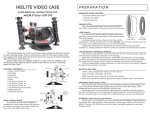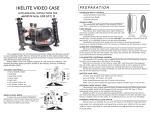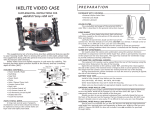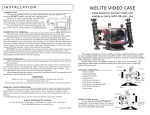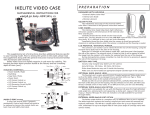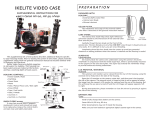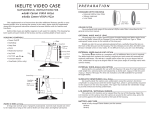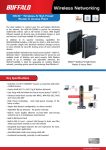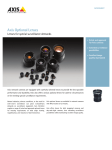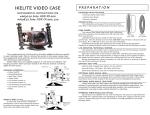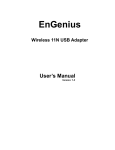Download Ikelite 6038.83 underwater camera housing
Transcript
IKELITE VIDEO CASE PREPARATION SUPPLEMENTAL INSTRUCTIONS FOR PACKAGED WITH HOUSING__________________________________________________ #60 38.83 SONY DCR-SR190, 20 0, 290 , 30 0 • External UR/Pro Color Filter • Internal Lens Shade • Silicone Lubricant COLOR FILTER_____________________________________ The installation and usage of the external UR/Pro color filter is described in the general instruction manual. #6038.83 Sony DCR-SR190, 200, 290, 300 LENS SHADE_______________________________________ The internal lens shade helps block light reflection/ refraction caused by the interaction of the external color External Internal filter and the port. Color Filter Lens Shade Carefully thread the lens shade on the front of the camera lens. The lens threads are very fine; DO NOT cross thread. It should screw on very easily. If it is difficult to turn, you are cross threading. Completely thread the lens shade into the camera to avoid any potential clearance or sealing problems when the camera is installed and the housing is sealed. This supplemental set of instructions describes additional features specific to your housing model. Prior to testing the system in the water, please read this supplement along with the general instruction manual to become familiar with its features and functions. Power Zoom Ikelite Video Cases are slightly negative Power in salt water for stability. This housing has been water pressure tested at the factory and has a working depth of 60m (200'). HOUSING CONTROLS______________ • Power On/Off / Mode • Start/Stop • Power Zoom • Photo • LCD Screen Control #1 • LCD Screen Control #2 • LCD Screen Control #3 • LCD Reversing Circuit On/Off Mirror Touch Pad Port Lid Snap Bottom Bar Base Snap Shot On/Off for Reverse Circuit MAIN O-RING #0109_____________ O-rings last several years if properly maintained. Control seals should not need to be replaced as long as the control shafts are kept clean and lightly lubricated. Start/ Stop LCD MONITOR / EXTERNAL MIRROR_________________________________________ The camera's LCD monitor can be viewed from the rear of the housing, using the external mirror featured on the side of the housing. Open the LCD monitor on the camera, rotate 180°, and then press it back against the side of the camera. The external mirror is hinged so that it can be opened to reflect the image from the camera's LCD monitor for viewing from the rear of the housing. During transportation, please remember to close the mirror by pressing it against the rubber on the lid snap. BATTERY AND TAPE__________________________________________________________ Install a fully charged Sony battery on the camera: Sony NP-FP50, NP-FP60, NP-FP90 Other brand batteries may not fit inside the housing. Make sure you have loaded an appropriate digital cassette tape in the camera. OPTIONAL WIDE ANGLE LENS__________________________________________ The housing’s port accepts optional 67mm threaded waterproof Wide-Angle lenses such as the Ikelite #6420 W-20, Epoque DCL-20 and Inon UWL-100 Type 2 and Sea&Sea (58070). These waterproof lenses secure to the outside of the lens port. Should you elect to use the optional Ikelite #6420 W-20, Epoque, Inon or Sea&Sea lens, carefully thread the waterproof lens on the front of the lens port. The lens threads are very fine; DO NOT cross thread. It should screw on very easily. If it is difficult to turn, you are cross threading. INTERNAL WIDE-ANGLE LENS OPTION ________________________________________ Special ports are available for use with the Raynox HD-5050 Pro high definition wide-angle lens. optional ports sold separately as dome port #9304 or flat lens port #9304.1. Raynox HD-5050 Pro lens not included. Lens no t available for purchase through Ikelite. IMAGE REVERSING CIRCUIT__________________________________________________ The image reversing circuit is mounted inside the housing. The circuit reverses (flips) the image and words on the LCD screen so that when the image is reflected in the external mirror, it appears correct left-to-right. Secure the camera to the tray and partially slide the camera and tray inside the housing so you can then connect the cable from the reversing circuit to the Remote port on the camera. The reversing circuit will automatically turn ON when connected to the camera and the camera is ON; the image and words in the LCD screen will appear in reverse. On/Off Switch An on/off switch is featured on the reversing circuit. Use the reversing circuit control on the housing to access the on/off switch on the circuit. The circuit will automatically turn ON when connected to the camera and the camera is ON. When turning the camera OFF, there is a 5-minute standby power down delay on the camera that occurs when the reversing circuit is ON during power down. Therefore to avoid the 5-minute power down delay, turn the camera OFF and also turn the circuit OFF to power down the camera immediately. Functions Locked Out When the reversing circuit is ON, some camera functions may be locked out. To correct for such a problem, temporarily turn the circuit OFF, change the function on the camera, and then turn the circuit back ON. The camera’s Microphone is also disabled when the reversing circuit is on. FINAL PREPARATION_________________________________________________________ Remove the lens cap and cord from the camera. Otherwise, they may interfere with the housing seal. The camera's auto focus feature is utilized underwater. For best results, move in close to your subject and use the wide angle range to shoot thru as little water as possible. The full zoom range is accessible underwater. Turn the camera’s built-in flash OFF. Chart shows recommended initial settings underwater. CAMERA Power On/Off Zoom Lever Focus Exposure Program AE Shutter Speed White Balance Steady Shot Built-in Flash – – – – – – – – – SETTING Camera (On) Wide Angle Setting Auto Mode Auto Mode Auto Mode 1/60 Normal Auto Mode (see section) Off Off WHITE BALANCE_____________________________________________________________ Initially set the white balance to Auto. Use the touch screen controls on the housing to change white balance. C olor F ilter : When using the color filter (during the day), set camera white balance to Indoor for 0-15 foot depth. For 15-80 foot depth, set white balance to Outdoor. V ideo-Lite: When using optional Video Lite at NIGHT, set the camera white balance to the Indoor position. During the DAY, use the Outdoor setting for subjects beyond 4-5 feet and the Indoor setting for closer subjects. INSTALLATION CAMERA TRAY________________________________________________________________ The camera mounts to the tray, which extends from the back plate of the housing. DO N OT remove the tray from the back plate. O’ring Position the camera against the two Back Plate Internal Lens Shade stabilizing pins on the tray and secure with the camera mounting bolt. The camera should fit easily on the tray and should be parallel with the sides of the tray. Make certain that the lens shade has been threaded completely into the camera to avoid any potential clearance or sealing problems when the camera is installed and the housing is sealed. Stabilizing INSERTING THE CAMERA____________________________ Pins Camera Tray Camera Mounting Bolt Check that the o’ring is clean and properly positioned on the lip of the clear housing back plate. Check that the lens shade is completely threaded into the camera. Once the camera is mounted to the tray as shown above, pull the housing controls out to provide clearance for installing the camera. Partially slide the camera into the housing so you can connect the reversing circuit cable to the Remote port on the camera. Make sure the lens shade on the front of the camera fits into the port recess in the front of the housing. DO NOT force this installation; the camera and tray should slide easily into place so the housings back plate o’ring is resting against the main housing body. In this position the lid snaps can be positioned over the lid hooks on the housing back plate and snapped into position to seal the housing. HOUSING CONTROLS_________________________________________________________ Slide the housing controls back in place making sure they properly align with the camera functions. Operate each control to see how it works with the camera. Some controls such as start/stop will be used frequently. Other controls may seldom be utilized. Refer to your camera owner's manual for the proper function of each camera control. Look thru the back to be sure that you can see into the viewfinder. When using the housing controls, especially the start/stop, do NOT use excessive force because you could damage the camera. CAUTION Remove t he lens cap and cord from the c amera. Oth erw ise, the cord may interfere with the h ou sing seal. I f the housing controls are n ot properly p ositioned , they coul d in terfere wit h th e housing seal. MANUAL FOCUS OPERATION________________________________________________ Manual focus may be preferred in low light levels or when the subject possesses little contrast. Set the focus switch to Manual to cancel the auto focus. If you want to manually adjust the focus, use LCD touch screen. To reactivate the auto focus, set the focus switch to Auto. IKELITE UNDERWATER SYSTEMS 50 West 33rd Street • PO Box 88100 • Indianapolis, IN 4620 8 USA • 317.923.4523 Email: [email protected] • www.ikelite.com 6038.83-01-0707


